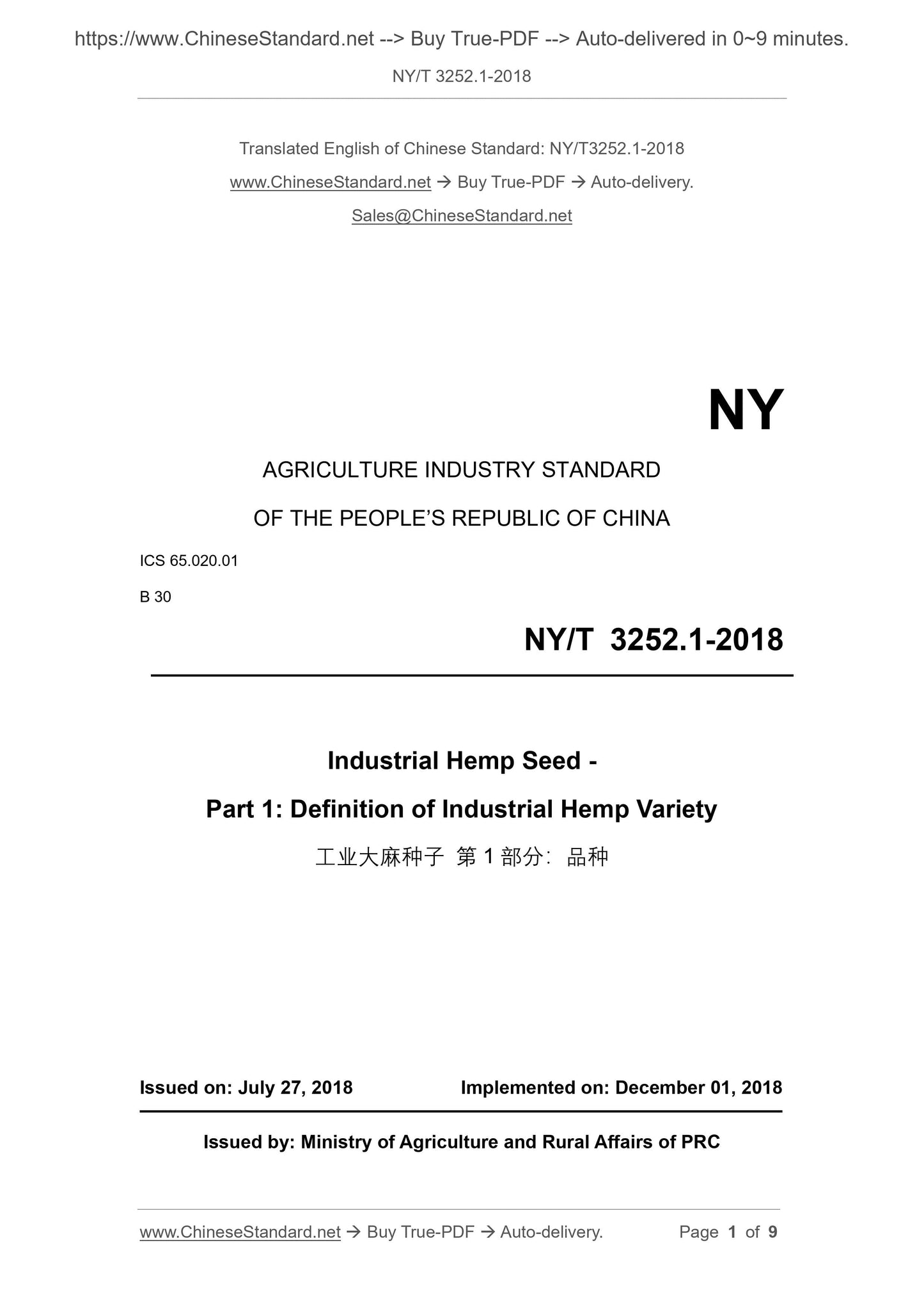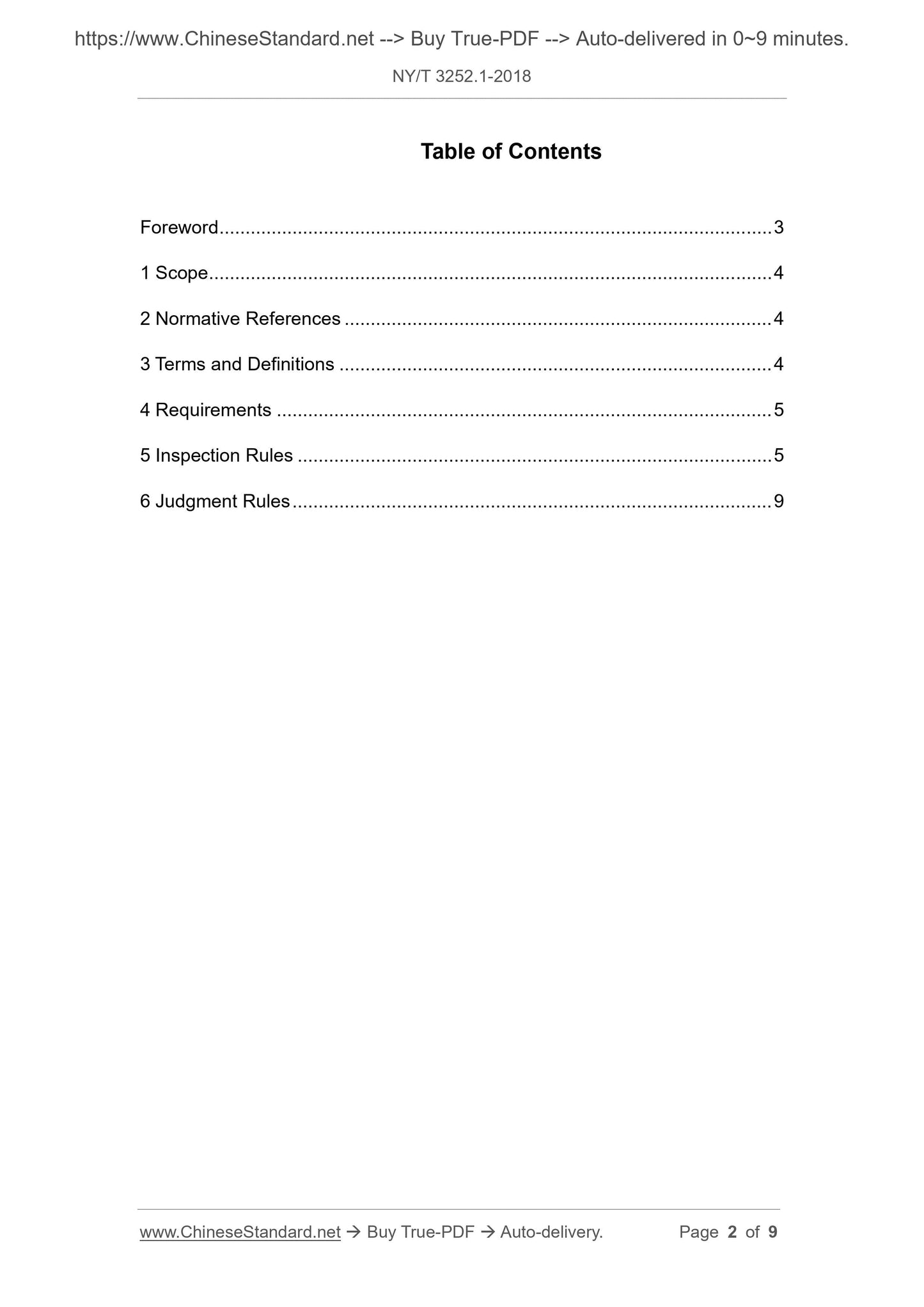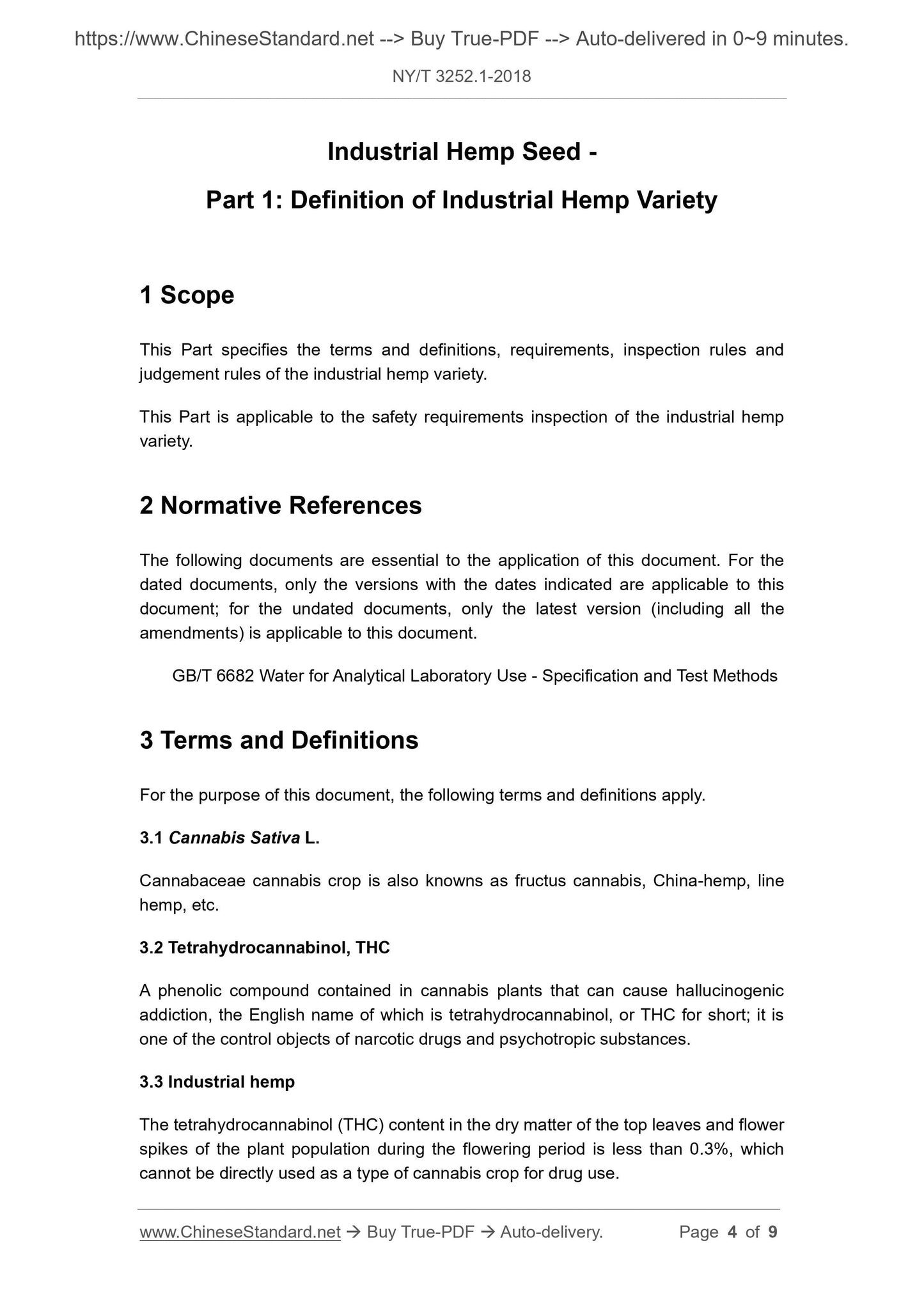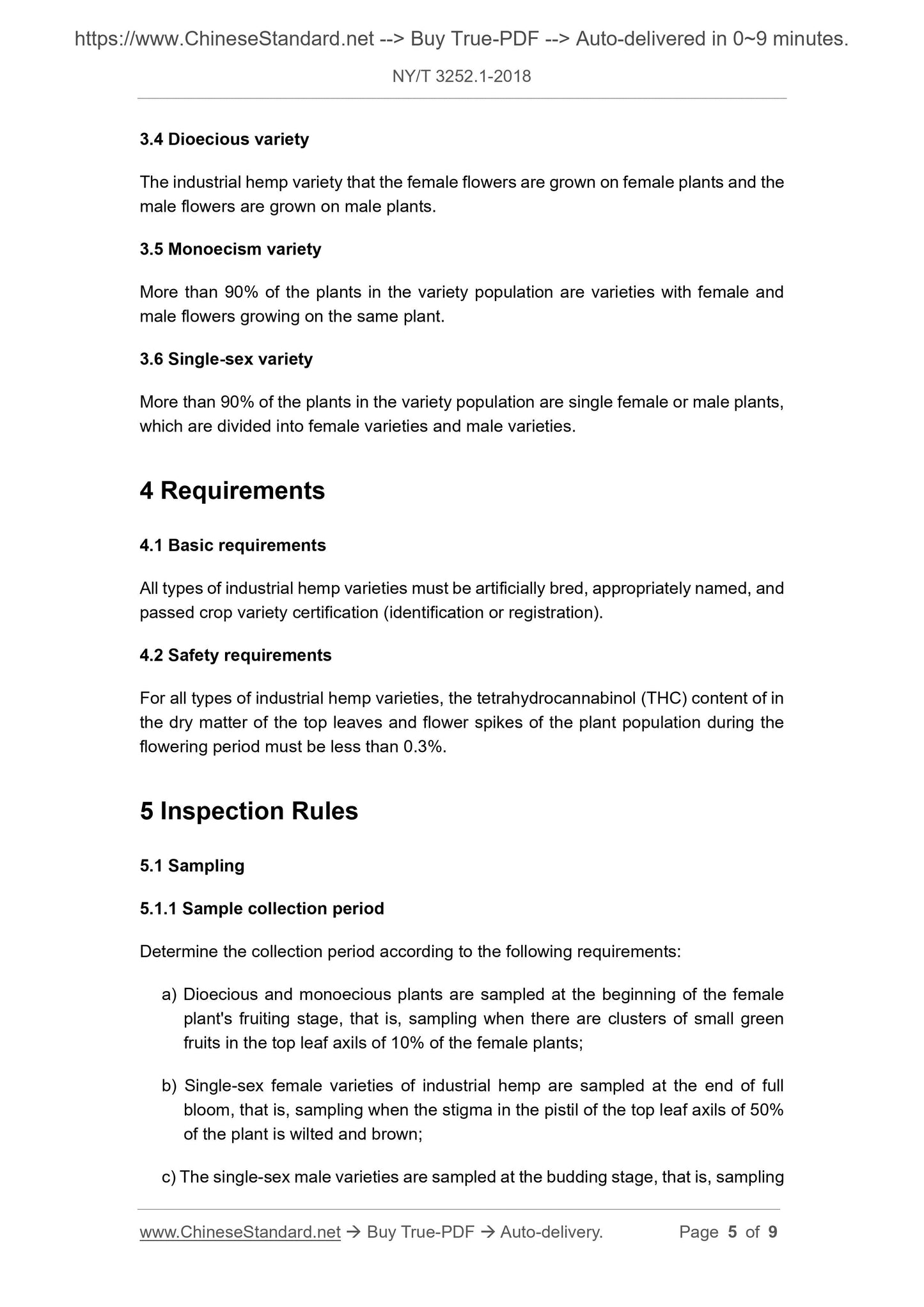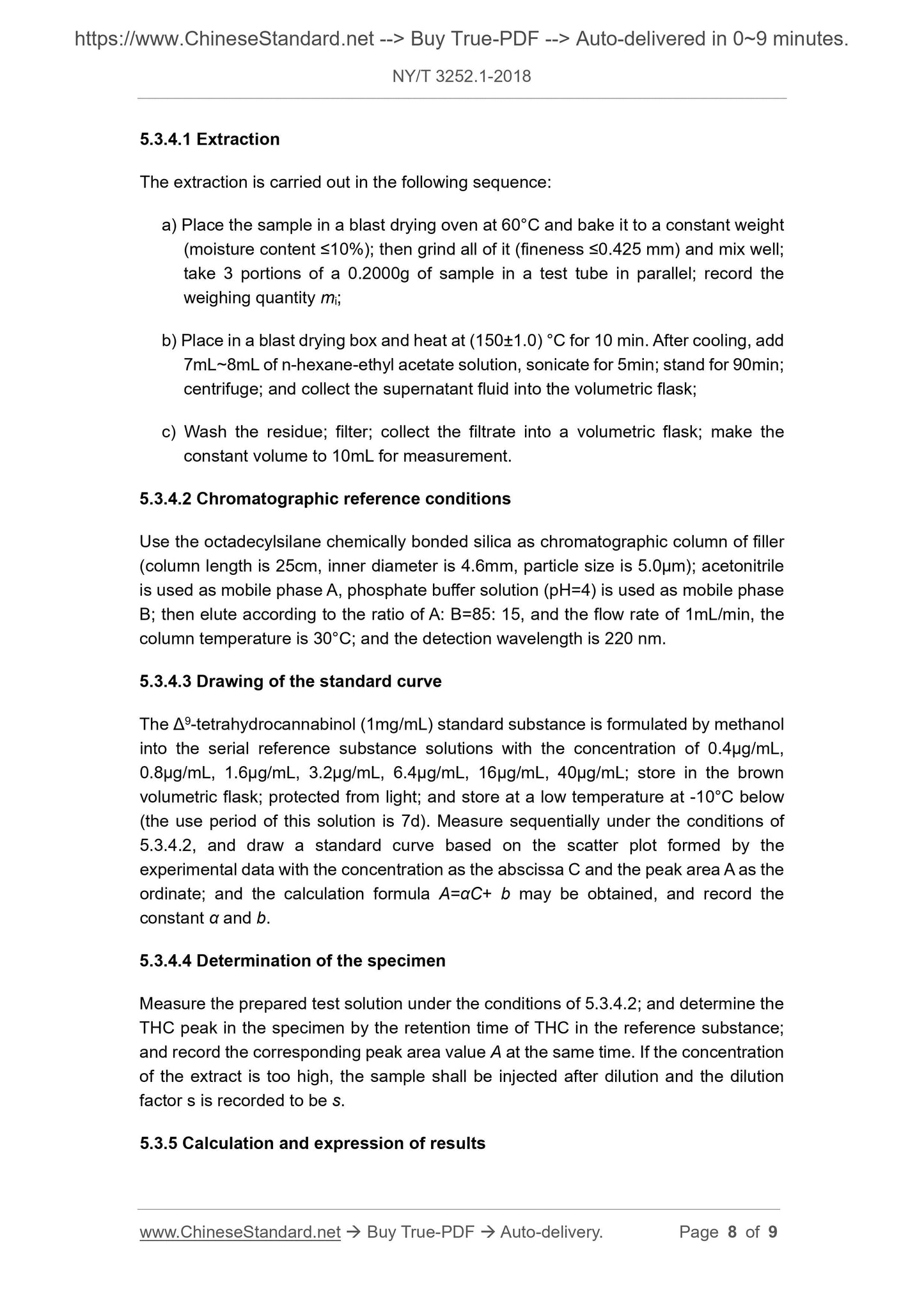1
/
of
5
PayPal, credit cards. Download editable-PDF and invoice in 1 second!
NY/T 3252.1-2018 English PDF (NY/T3252.1-2018)
NY/T 3252.1-2018 English PDF (NY/T3252.1-2018)
Regular price
$110.00 USD
Regular price
Sale price
$110.00 USD
Unit price
/
per
Shipping calculated at checkout.
Couldn't load pickup availability
Delivery: 3 seconds. Download true-PDF + Invoice.
Get QUOTATION in 1-minute: Click NY/T 3252.1-2018
Historical versions: NY/T 3252.1-2018
Preview True-PDF (Reload/Scroll if blank)
NY/T 3252.1-2018: Industrial hemp seed - Part 1: Definition of industrial hemp variety
NY/T 3252.1-2018
NY
AGRICULTURE INDUSTRY STANDARD
OF THE PEOPLE’S REPUBLIC OF CHINA
ICS 65.020.01
B 30
Industrial Hemp Seed -
Part 1: Definition of Industrial Hemp Variety
ISSUED ON: JULY 27, 2018
IMPLEMENTED ON: DECEMBER 01, 2018
Issued by: Ministry of Agriculture and Rural Affairs of PRC
Table of Contents
Foreword ... 3
1 Scope ... 4
2 Normative References ... 4
3 Terms and Definitions ... 4
4 Requirements ... 5
5 Inspection Rules ... 5
6 Judgment Rules ... 9
Industrial Hemp Seed -
Part 1: Definition of Industrial Hemp Variety
1 Scope
This Part specifies the terms and definitions, requirements, inspection rules and
judgement rules of the industrial hemp variety.
This Part is applicable to the safety requirements inspection of the industrial hemp
variety.
2 Normative References
The following documents are essential to the application of this document. For the
dated documents, only the versions with the dates indicated are applicable to this
document; for the undated documents, only the latest version (including all the
amendments) is applicable to this document.
GB/T 6682 Water for Analytical Laboratory Use - Specification and Test Methods
3 Terms and Definitions
For the purpose of this document, the following terms and definitions apply.
3.1 Cannabis Sativa L.
Cannabaceae cannabis crop is also knowns as fructus cannabis, China-hemp, line
hemp, etc.
3.2 Tetrahydrocannabinol, THC
A phenolic compound contained in cannabis plants that can cause hallucinogenic
addiction, the English name of which is tetrahydrocannabinol, or THC for short; it is
one of the control objects of narcotic drugs and psychotropic substances.
3.3 Industrial hemp
The tetrahydrocannabinol (THC) content in the dry matter of the top leaves and flower
spikes of the plant population during the flowering period is less than 0.3%, which
cannot be directly used as a type of cannabis crop for drug use.
3.4 Dioecious variety
The industrial hemp variety that the female flowers are grown on female plants and the
male flowers are grown on male plants.
3.5 Monoecism variety
More than 90% of the plants in the variety population are varieties with female and
male flowers growing on the same plant.
3.6 Single-sex variety
More than 90% of the plants in the variety population are single female or male plants,
which are divided into female varieties and male varieties.
4 Requirements
4.1 Basic requirements
All types of industrial hemp varieties must be artificially bred, appropriately named, and
passed crop variety certification (identification or registration).
4.2 Safety requirements
For all types of industrial hemp varieties, the tetrahydrocannabinol (THC) content of in
the dry matter of the top leaves and flower spikes of the plant population during the
flowering period must be less than 0.3%.
5 Inspection Rules
5.1 Sampling
5.1.1 Sample collection period
Determine the collection period according to the following requirements:
a) Dioecious and monoecious plants are sampled at the beginning of the female
plant's fruiting stage, that is, sampling when there are clusters of small green
fruits in the top leaf axils of 10% of the female plants;
b) Single-sex female varieties of industrial hemp are sampled at the end of full
bloom, that is, sampling when the stigma in the pistil of the top leaf axils of 50%
of the plant is wilted and brown;
c) The single-sex male varieties are sampled at the budding stage, that is, sampling
5.3.4.1 Extraction
The extraction is carried out in the following sequence:
a) Place the sample in a blast drying oven at 60°C and bake it to a constant weight
(moisture content ≤10%); then grind all of it (fineness ≤0.425 mm) and mix well;
take 3 portions of a 0.2000g of sample in a test tube in parallel; record the
weighing quantity mi;
b) Place in a blast drying box and heat at (150±1.0) °C for 10 min. After cooling, add
7mL~8mL of n-hexane-ethyl acetate solution, sonicate for 5min; stand for 90min;
centrifuge; and collect the supernatant fluid into the volumetric flask;
c) Wash the residue; filter; collect the filtrate into a volumetric flask; make the
constant volume to 10mL for measurement.
5.3.4.2 Chromatographic reference conditions
Use the octadecylsilane chemically bonded silica as chromatographic column of filler
(column length is 25cm, inner diameter is 4.6mm, particle size is 5.0μm); acetonitrile
is used as mobile phase A, phosphate buffer solution (pH=4) is used as mobile phase
B; then elute according to the ratio of A: B=85: 15, and the flow rate of 1mL/min, the
column temperature is 30°C; and the detection wavelength is 220 nm.
5.3.4.3 Drawing of the standard curve
The Δ9-tetrahydrocannabinol (1mg/mL) standard substance is formulated by methanol
into the serial reference substance solutions with the concentration of 0.4μg/mL,
0.8μg/mL, 1.6μg/mL, 3.2μg/mL, 6.4μg/mL, 16μg/mL, 40μg/mL; store in the brown
volumetric flask; protected from light; and store at a low temperature at -10°C below
(the use period of this solution is 7d). Measure sequentially under the conditions of
5.3.4.2, and draw a standard curve based on the scatter plot formed by the
experimental data with the concentration as the abscissa C and the peak area A as the
ordinate; and the calculation formula A=αC+ b may be obtained, and record the
constant α and b.
5.3.4.4 Determination of the specimen
Measure the prepared test solution under the conditions of 5.3.4.2; and determine the
THC peak in the specimen by the retention time of THC in the reference substance;
and record the corresponding peak area value A at the same time. If the concentration
of the extract is too high, the sample shall be injected after dilution and the dilution
factor s is recorded to be s.
5.3.5 Calculation and expression of results
Get QUOTATION in 1-minute: Click NY/T 3252.1-2018
Historical versions: NY/T 3252.1-2018
Preview True-PDF (Reload/Scroll if blank)
NY/T 3252.1-2018: Industrial hemp seed - Part 1: Definition of industrial hemp variety
NY/T 3252.1-2018
NY
AGRICULTURE INDUSTRY STANDARD
OF THE PEOPLE’S REPUBLIC OF CHINA
ICS 65.020.01
B 30
Industrial Hemp Seed -
Part 1: Definition of Industrial Hemp Variety
ISSUED ON: JULY 27, 2018
IMPLEMENTED ON: DECEMBER 01, 2018
Issued by: Ministry of Agriculture and Rural Affairs of PRC
Table of Contents
Foreword ... 3
1 Scope ... 4
2 Normative References ... 4
3 Terms and Definitions ... 4
4 Requirements ... 5
5 Inspection Rules ... 5
6 Judgment Rules ... 9
Industrial Hemp Seed -
Part 1: Definition of Industrial Hemp Variety
1 Scope
This Part specifies the terms and definitions, requirements, inspection rules and
judgement rules of the industrial hemp variety.
This Part is applicable to the safety requirements inspection of the industrial hemp
variety.
2 Normative References
The following documents are essential to the application of this document. For the
dated documents, only the versions with the dates indicated are applicable to this
document; for the undated documents, only the latest version (including all the
amendments) is applicable to this document.
GB/T 6682 Water for Analytical Laboratory Use - Specification and Test Methods
3 Terms and Definitions
For the purpose of this document, the following terms and definitions apply.
3.1 Cannabis Sativa L.
Cannabaceae cannabis crop is also knowns as fructus cannabis, China-hemp, line
hemp, etc.
3.2 Tetrahydrocannabinol, THC
A phenolic compound contained in cannabis plants that can cause hallucinogenic
addiction, the English name of which is tetrahydrocannabinol, or THC for short; it is
one of the control objects of narcotic drugs and psychotropic substances.
3.3 Industrial hemp
The tetrahydrocannabinol (THC) content in the dry matter of the top leaves and flower
spikes of the plant population during the flowering period is less than 0.3%, which
cannot be directly used as a type of cannabis crop for drug use.
3.4 Dioecious variety
The industrial hemp variety that the female flowers are grown on female plants and the
male flowers are grown on male plants.
3.5 Monoecism variety
More than 90% of the plants in the variety population are varieties with female and
male flowers growing on the same plant.
3.6 Single-sex variety
More than 90% of the plants in the variety population are single female or male plants,
which are divided into female varieties and male varieties.
4 Requirements
4.1 Basic requirements
All types of industrial hemp varieties must be artificially bred, appropriately named, and
passed crop variety certification (identification or registration).
4.2 Safety requirements
For all types of industrial hemp varieties, the tetrahydrocannabinol (THC) content of in
the dry matter of the top leaves and flower spikes of the plant population during the
flowering period must be less than 0.3%.
5 Inspection Rules
5.1 Sampling
5.1.1 Sample collection period
Determine the collection period according to the following requirements:
a) Dioecious and monoecious plants are sampled at the beginning of the female
plant's fruiting stage, that is, sampling when there are clusters of small green
fruits in the top leaf axils of 10% of the female plants;
b) Single-sex female varieties of industrial hemp are sampled at the end of full
bloom, that is, sampling when the stigma in the pistil of the top leaf axils of 50%
of the plant is wilted and brown;
c) The single-sex male varieties are sampled at the budding stage, that is, sampling
5.3.4.1 Extraction
The extraction is carried out in the following sequence:
a) Place the sample in a blast drying oven at 60°C and bake it to a constant weight
(moisture content ≤10%); then grind all of it (fineness ≤0.425 mm) and mix well;
take 3 portions of a 0.2000g of sample in a test tube in parallel; record the
weighing quantity mi;
b) Place in a blast drying box and heat at (150±1.0) °C for 10 min. After cooling, add
7mL~8mL of n-hexane-ethyl acetate solution, sonicate for 5min; stand for 90min;
centrifuge; and collect the supernatant fluid into the volumetric flask;
c) Wash the residue; filter; collect the filtrate into a volumetric flask; make the
constant volume to 10mL for measurement.
5.3.4.2 Chromatographic reference conditions
Use the octadecylsilane chemically bonded silica as chromatographic column of filler
(column length is 25cm, inner diameter is 4.6mm, particle size is 5.0μm); acetonitrile
is used as mobile phase A, phosphate buffer solution (pH=4) is used as mobile phase
B; then elute according to the ratio of A: B=85: 15, and the flow rate of 1mL/min, the
column temperature is 30°C; and the detection wavelength is 220 nm.
5.3.4.3 Drawing of the standard curve
The Δ9-tetrahydrocannabinol (1mg/mL) standard substance is formulated by methanol
into the serial reference substance solutions with the concentration of 0.4μg/mL,
0.8μg/mL, 1.6μg/mL, 3.2μg/mL, 6.4μg/mL, 16μg/mL, 40μg/mL; store in the brown
volumetric flask; protected from light; and store at a low temperature at -10°C below
(the use period of this solution is 7d). Measure sequentially under the conditions of
5.3.4.2, and draw a standard curve based on the scatter plot formed by the
experimental data with the concentration as the abscissa C and the peak area A as the
ordinate; and the calculation formula A=αC+ b may be obtained, and record the
constant α and b.
5.3.4.4 Determination of the specimen
Measure the prepared test solution under the conditions of 5.3.4.2; and determine the
THC peak in the specimen by the retention time of THC in the reference substance;
and record the corresponding peak area value A at the same time. If the concentration
of the extract is too high, the sample shall be injected after dilution and the dilution
factor s is recorded to be s.
5.3.5 Calculation and expression of results
Share
